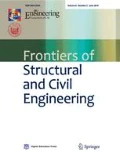Abstract
Freeze-thaw damage is one of the main threats to the long time performance of the concrete pavement in the cold regions. This project aims to evaluate the influence of the freeze-thaw damages on pavement distresses under different climate conditions. Based on the Long-Term Pavement Performance (LTPP) data base, the freeze-thaw damage generated by four different kinds of climate conditions are considered in this project: wet-freeze, wet-non freeze, dryfreeze and dry-non freeze. The amount of the transverse crack and the joint spalling, along with the International Roughness Index (IRI) are compared among the test sections located in these four different climate conditions. The back calculation with the Falling Weight Deflectometer (FWD) test results based on the ERES and the Estimation of Concrete Pavement Parameters (ECOPP) methods are conducted to obtain concrete slab elastic modulus and the subgrade k-value. These two parameters both decrease with service time under freeze condition. Finally, MEPDG simulation is conducted to simulate the IRI development with service year. These results showed the reasonable freeze-thaw damage development with pavement service life and under different climate conditions.
Similar content being viewed by others
References
Thom N. Principles of Pavement Engineering. London: Thomas Telford, 2008
Roberts F L. Hot Mix Asphalt Materials, Mixture Design and Construction. Lanham: National Asphalt Pavement Association, 1991
Johnson A M. Best Practices Handbook on Asphalt Pavement Maintenance. Minneapolis: University of Minnesota, 2000
Valenza J J, Scherer G W. Mechanism for salt scaling. Journal of the American Ceramic Society, 2006, 89(4): 1161–1179
Scherer G W, Valenza J J II, Simmons G. New methods to measure liquid permeability in porous materials. Cement and Concrete Research, 2007, 37(3): 386–397
Valenza J J II, Scherer G W. Mechanism for salt scaling of a cementitious surface. Materials and Structures, 2007, 40(3): 259–268
Li W, Pour-Ghaz M, Castro J, Weiss J. Water absorption and critical degree of saturation relating to freeze-thaw damage in concrete pavement joints. Journal of Materials in Civil Engineering, 2011, 24(3): 299–307
Lee H. Effects of Various Deicing Chemicals on Pavement Concrete Deterioration. In: Mid-Continente Transportation Symposium Proceedings. Washington: The National Academies of Sciences, Engineering, and Medicine, 2000
Simonsen E, Isacsson U. Soil behavior during freezing and thawing using variable and constant confining pressure triaxial tests. Canadian Geotechnical Journal, 2001, 38(4): 863–875
Wang K, Nelsen D E, Nixon W A. Damaging effects of deicing chemicals on concrete materials. Cement and Concrete Composites, 2006, 28(2): 173–188
Miller J S, Bellinger W Y. Distress Identification Manual for the Long-Term Pavement Performance Program. Washington: US Department of Transportation, 2003
Witczak M, Andrei D, Houston W. Guide for Mechanistic- Empirical Design of New and Rehabilitated Pavement Structures. Washington: Transportation Research Board of the National Research Council, 2004. 1–91
Varma S, Emin Kutay M. Back calculation of viscoelastic and nonlinear flexible pavement layer properties from falling weight deflections. International Journal of Pavement Engineering, 2016, 17(5): 388–402
Sharma S, Das A. Back calculation of pavement layer moduli from falling weight deflectometer data using an artificial neural network. Canadian Journal of Civil Engineering, 2008, 35(1): 57–66
Sangghaleh A, Pan E, Green R, Wang R, Liu X, Cai Y. Back calculation of pavement layer elastic modulus and thickness with measurement errors. International Journal of Pavement Engineering, 2014, 15(6): 521–531
Wu C L, Todres H. Evaluation of Roller-Compacted Concrete Pavements Using Nondestructive Load Testing. Washington: National Academy Press, 1995
Gillespie T D. Effects of Heavy-Vehicle Characteristics on Pavement Response and Performance. National Cooperative Highway Research Program Report, No. 353, 1993, 1–126
Ioannides A, Barenberg E, Lary J A. Interpretation of falling weight deflectometer results using principles of dimensional analysis. In: Proceedings of the 4th international conference on concrete pavement design and rehabilitation. West Lafayette: Purdue University, 1989
Smith K. Performance of Concrete Pavements. Volume II: Evaluation of Inservice Concrete Pavements. Washington: The National Academies of Sciences, Engineering, and Medicine, 1998
Lee W, Bohra N C, Altschaeffl A G, White T D. Resilient modulus of cohesive soils and the effect of freeze–thaw. Canadian Geotechnical Journal, 1995, 32(4): 559–568
Chu K C, Rutt B K. Polyvinyl alcohol cryogel: An ideal phantom material for MR studies of arterial flow and elasticity. Magnetic Resonance in Medicine, 1997, 37(2): 314–319
The Mechanistic-Empirical Pavement Design Guide. 2011
Ceylan H, Coree B J, Gopalakrishnan K. Strategic plan for implementing mechanistic-empirical pavement design guide in iowa. In: Transportation Research Board 85th Annual Meeting. Washington: Transportation Research Board, 2006
Acknowledgements
The first author acknowledges the financial support from China Scholarship Council under No. 201406370141.
Author information
Authors and Affiliations
Corresponding author
Rights and permissions
About this article
Cite this article
Guo, S., Dai, Q. & Hiller, J. Investigation on the freeze-thaw damage to the jointed plain concrete pavement under different climate conditions. Front. Struct. Civ. Eng. 12, 227–238 (2018). https://doi.org/10.1007/s11709-017-0426-6
Received:
Accepted:
Published:
Issue Date:
DOI: https://doi.org/10.1007/s11709-017-0426-6




